Emotions
Emotions are great assets to the individual giving richness and fullness to his/her life
Published
3 years agoon
An Emotion is nothing but one phase of a comprehensive internal adjustment that takes place in order to enable higher animals to react as coordinated entities and to be more completely the master of sudden changes in their environment.
An emotion is dynamic: It stimulates behavior that makes the person less rational as the emotion takes possession of him. It is concerned with mobilization of available energy reserves. By utilizing necessary movements and functions and by inhibiting or accelerating them in terms of his needs, and emotion may affect an individual’s entire being. An emotion is an affective experience that results from generalized adjustment. This affective experience is accompanied by mental and psychological stirred up states in the individual giving richness and fullness to his life. However, if the emotions secure too great a hold on an individual his behavior may display irrational tendencies.
Emotional expression results from the fusion of complex sensory experiences as inherited or learned. Perception of a stimulus starts the emotional reaction which is not fully experienced until the feelings and other affective element have been aroused through the operation of the autonomic nervous system. It is through the help of the endocrine system that responses are diffused and spread throughout the body affecting the human being as a whole. Thus emotions have both inherited and learned reaction patterns, involving visceral behavior and affective experiences that are generalized through the functioning of the vital functions, change of heart action and release into blood stream of energizing products of the endocrine secretions. According to Sartain et. al (1962) there are three aspects of emotion. They are physiological changes in the body, the emotional behavior shown by the person and personal emotional experience in which the individual knows and feels the emotions.
Awareness of the Emotion. A specific stimulus is required to activate inherited potentialities and to utilize the learned in the fusion of the complex experiences into what is called an emotional experience. Stimuli must be associated with interest or desire in order to become emotion arousing factors. Certain stimuli are emotion arousing of one time and not at other times. A stimulus will produce emotion in terms of interpretation of the stimulus by the individual. The duration of an emotional response is determined by the persistence of the stimuli. Two training and experience of an individual at any one time of his life influence the effectiveness of emotion arousing stimuli. As the individual develops as his interests and desires as his health or general understanding is changed as are his emotional reaction possibilities affected. The sick person may be aroused easily by stimuli that would not disturb him if he/she were well and the healthy person may be stimulated by factors that would not affect him if he were ill. The effectiveness of the stimulating force changes with situation. It is conditioned by an individual’s desires at the moment his/her state of health and their understanding of all the attendant circumstances. The experience during the emotion is an individual one. It makes one intensely conscious of him/herself and tends to spread over the field of consciousness. We are wild with rage, frozen stiff with fear, filled with enthusiasm, thrilled with joy, overwhelmed by grief and in the depth of despair. These affective mental qualities arise from the facilitation, inhibition and obstruction of the impulses resulting from external and internal stimuli. Through maturation, learning or conditioning emotional patterns develop during babyhood to such a degree that definite emotional states are displayed. Emotional patterns are established, modified, expanded or represented. As an individual develops through childhood and adolescence into adulthood, his emotions assume characteristic behavior that causes the recognition of them as fear, anger, disgust, grief, hatred, affection and jealously. As he/she become more proficient in conveying to others his true feelings, an appraisal of the emotional experience is made easier. The adolescent’s appreciation of value, ambitions or ideals tend to influence his total behavior. His emotionalized attitudes reflect social values and interpretation. He learns to respond emotionally to other persons, objects or situations in terms of their degree of social acceptance. Also his impulsive emotions tend to become attached to persons, institution, duties, ideas, ideals and philosophies.
Hi, I’m Aarti, My Psychoanalytical approach towards my clients is to empower them to better their lives through improving their relationship with themselves. I believe shame and guilt is a common barrier to change. I aim to guide my clients through re authoring their narratives where shame, guilt, and other problems have less power and take up less space.



